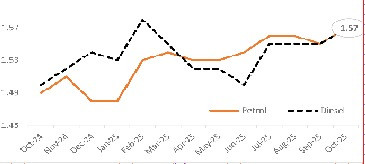
A fortnight ago, this column analysed Zimbabwe’s macro-economic performance in the third quarter of 2025.
The main focus was specifically on the exchange rate, inflation, and public finances.
In this week’s issue, I re-visited the state of the economy, concentrating on the political and regulatory environment, as well as developments in the money supply, fuel, and electricity.
I also highlight potential macroeconomic risks to the stability achieved so far this year and propose possible solutions for fostering strong, sustainable, and inclusive growth.
Political economy
As of the end of the third quarter (3Q25), a notably stable political environment, marked by a decrease in reports of politically motivated violence, harassment, and abuse, was experienced across the country.
Experts widely agree that political stability is fundamental to fostering a conducive environment for business success, profitability, and overall growth.
This underscores the critical importance for business leaders to vigilantly monitor political developments — doing so enables them to proactively manage risks, maintain business continuity, and make strategic decisions with confidence.
- Letter from America: The war in Ukraine has brought the best and the worst in man
- Outcry as Chinese miners scoop precious stones from Malawi communities
- Green Fuel fulfills its Chisumbanje pledge
- Letter from America: The war in Ukraine has brought the best and the worst in man
Keep Reading
While the stability witnessed to date is promising, recent media reports highlight rising factional tensions within the ruling party, Zanu-PF, and increase the likelihood of more instability.
These tensions appear to stem from increased political donations by well-connected elites, who are suspected of exerting undue influence through public procurement.
Meanwhile, persistent high living costs and entrenched poverty threaten social cohesion, posing risks of political unrest, or policy shifts. Ignoring these signs could lead to unforeseen disruptions, just as regulatory, tax, and trade landscapes may shift rapidly.
For informed, strategic decision-making, business executives must stay alert to these developments—they could significantly impact the investment climate and economic stability.
Regulatory environment
The Government of Zimbabwe (GoZ) is currently engaged in finalising the National Development Strategy 2 (NDS2).
This economic blueprint, scheduled for launch in the fourth quarter, is designed to guide policy implementation by shaping the national budgets for 2026-2030, with the primary objective of elevating the country to upper-middle-income status by 2030.
To accomplish this, Treasury has already commenced streamlining regulations and reducing regulatory fees and levies.
In September, it announced substantial reductions in regulatory costs for the agricultural sector, particularly for dairy, livestock, and stock feed.
These regulatory reductions were subsequently extended to other industries, including tourism and transportation. While these reforms are commendable, as they are expected to improve the cost of doing business in Zimbabwe, their implementation may be delayed by the need to establish various Acts of Parliament to enact the proposed changes.
As such, responsible authorities, including the Parliament of Zimbabwe, must expedite this critical reform process to help turbocharge economic recovery and growth.
Money supply
The exchange rate and price stability observed year-to-date are mainly due to the RBZ’s strong liquidity management and Treasury's fiscal discipline. Latest data from the Reserve Bank of Zimbabwe (RBZ) show a sharp decline in the monthly growth of the total money supply (broad money, or M3), from nearly 20% in July 2024 to below 0% in September.
On average, M3 growth dropped from around 10% in May-December 2024 to 2% in January-September 2025, emphasising the bank’s strict monetary targeting.
Broad money supply
Monetary (and fiscal) discipline is key to stabilising prices, as it suppresses exchange rate pass through into domestic prices.
The Monetarist view of inflation holds that price inflation is primarily a monetary issue. To maintain stable prices, the growth of money supply should match that of the real economy. If not, there will be more money in circulation than goods available, which can lead to price increases.
As such, this confirms that both the stable exchange rate and price inflation experienced year-to-date are primarily attributed to the RBZ’s strict monetary targeting.
Be that as it may, the RBZ must publish reserve money (M0) data on time, as reliance on M3 can mask an underlying problem.
M0 (notes & coins in circulation and commercial banks' deposits with the RBZ) is the most price sensitive component of money supply because it is directly injected into the system by the central bank, and its components function more as a medium of exchange rather than a store of value.
Looking ahead, with increased household and government spending expected in the fourth quarter (4Q25), ZiG liquidity is likely to grow substantially.
This could exert downward pressure on the exchange rate, particularly in alternative markets.
Full article on www.theindependent.co.zw
Sibanda is an economist and researcher. His perspectives are independent and do not necessarily reflect those of his employer. — [email protected].
Therefore, fiscal authorities are urged to resist this pressure and maintain fiscal discipline by staying within their approved budgets.
In summary, fiscal restraint is crucial for achieving monetary discipline, which will have desired spillover effects on the exchange rate and price stability.
Fuel
High fuel prices significantly increase business operating costs in the economy.
Fuel is used as an input in the production process and serves as a perfect substitute for electricity during power rationing schedules, which have become frequent and severe.
In its latest review of fuel pump price caps for October 2025, the Zimbabwe Energy Regulatory Authority (Zera) raised the price of a litre of diesel and petrol by US$0,02, bringing it to US$1,57.
These prices are based on M-1, a baseline cost that includes factors like international crude oil prices, transportation and shipping costs, port charges, insurance, and taxes.
Fuel pump prices (US$)
Although domestic fuel prices remain too high compared to regional and global averages, they have remained relatively stable since July, consistent with obtaining global patterns.
Global crude oil prices were subdued during this period, mainly due to market oversupply amid Opec+ output increases.
However, risks to global crude oil prices remain, with sanctions on Russia and Iran adding to geopolitical concerns.
To lower fuel-related costs and engender durable stability, authorities should cut taxes and levies on fuel, which account for about 30% of the domestic retail price. Besides taxes, structural problems and market dominance—such as the nearly monopolistic ethanol-blending market—need to be addressed. Additionally, increasing competition in the fuel sector is essential, as bulk fuel importers also control the retail fuel market.
Electricity sub-sector developments
Electricity remains in acute short supply as households and businesses continue to grapple with lengthy power rationing schedules, averaging 15 hours per day.
This domestic production deficit stems from rampant public sector corruption, government underinvestment in energy projects, a lack of a feasible investment framework to attract private sector investors, aging thermal stations that are no longer economically viable to operate, slow response to suboptimal tariffs, and vandalism of distribution infrastructure, among other factors.
Electrical energy imports
Meanwhile, ZimStat data show the country imported electrical energy worth US$9,2 million in August, a 22,2% decrease from US$11,8 million the previous month. Cumulatively, electrical energy imports totaled US$78,34 million in the first eight months, a 41,8% decline from US$134,63 million during the same period in 2024.
This sharp drop has occurred despite worsening domestic power conditions, mainly due to a lack of excess capacity in the region, increasing internal foreign currency constraints, or growing electricity debt arrears to the regional power pool.
As a result, I expect the current situation — limited electrical energy imports to augment domestic production—to continue in the fourth quarter.
Consequently, this problem will persist in sustaining ongoing power load shedding.
Businesses and households are therefore encouraged to conserve energy and invest in affordable and clean alternatives, such as rooftop solar, to reduce strain on their budgets.
Macroeconomic risks
While year to date the economy has shown strong signs of stability — such as stable exchange rates and prices — it still faces numerous risks, making this relative stability fragile.
As I explained in this column a fortnight ago, fiscal pressures are mounting. Authorities are struggling to meet obligations when they fall due, leading to increasing debt arrears and penalties. Additionally, with farmers expected to increase planted hectares, Treasury will need to spend more on input support for the 2025/26 agricultural season.
Furthermore, the formal economy continues to decline. This hampers domestic resource mobilisation by increasing resource leakages — such as corruption and illicit dealings — disrupting efficient resource allocation, and diminishing the effectiveness of fiscal and monetary policies in managing the economy.
Additionally, the absence of a comprehensive, whole-of-government plan to boost ZiG demand across all sectors of the economy sustains and deepens dollarisation. Externally, worsening geopolitical tensions and resulting geoeconomic fragmentation, such as trade tariff wars, pose significant economic risks for long standing net importers such as Zimbabwe.
Sibanda is an economist and researcher. His perspectives are independent and do not necessarily reflect those of his employer. — [email protected].











